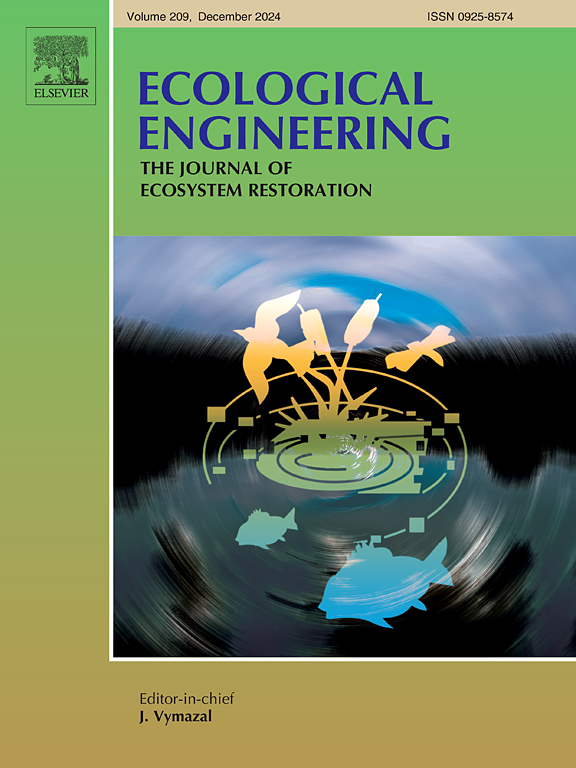Wetland topography drives salinity resilience in freshwater tidal ecosystems
IF 3.9
2区 环境科学与生态学
Q1 ECOLOGY
引用次数: 0
Abstract
The restoration and creation of tidal freshwater wetlands is increasingly becoming important, yet the success of these efforts is limited by salt intrusion, a growing concern due to climate change and human activities. Key topographical features, such as (re)constructed channel network, might help mitigate salt intrusion in these areas. Using a hydrodynamic model and idealized topographies based on real-world data from natural marshes and various constructed wetlands, we analysed how topographies respond to saltwater intrusion events. Our findings reveal that, although wetland topographies based on natural marshes experience faster salinity increases at the onset of an event, they also achieve quicker salinity reductions at its conclusion, resulting in shorter overall periods of salinization compared to artificial wetland designs (e.g. up to 8.10 % in the drought simulations and 48.72 % in the storm surge simulations). The rapid reduction in salinity is driven by the distinct topography of natural marshes, particularly the creek system, which amplifies salt fluxes. Compared to the reference topography, the natural marsh topography exhibited 6.50 % higher salt fluxes in drought (S + W) simulations and up to 41.02 % higher in storm surge (S + W) simulations. These findings emphasize the importance of incorporating natural marsh characteristics, such as slope and channel network design, into tidal freshwater wetland restoration and creation projects to improve resilience against salt intrusion and ensure their long-term sustainability in the face of climate change.

湿地地形驱动淡水潮汐生态系统的盐度恢复力
潮汐淡水湿地的恢复和创造正变得越来越重要,然而,由于气候变化和人类活动,这些努力的成功受到盐分入侵的限制,这是一个日益受到关注的问题。关键的地形特征,如(重新)构建的通道网络,可能有助于减轻这些地区的盐入侵。利用水动力学模型和基于自然沼泽和各种人工湿地的现实世界数据的理想化地形,我们分析了地形如何响应盐水入侵事件。我们的研究结果表明,尽管基于天然沼泽的湿地地形在事件开始时经历了更快的盐度增加,但在事件结束时也实现了更快的盐度降低,导致与人工湿地设计相比,总体盐渍化时间更短(例如,干旱模拟中高达8.10%,风暴潮模拟中高达48.72%)。盐度的迅速降低是由天然沼泽的独特地形驱动的,特别是小溪系统,它增加了盐的通量。与参考地形相比,自然沼泽地形在干旱(S + W)模拟中盐通量增加6.50%,在风暴潮(S + W)模拟中盐通量增加41.02%。这些发现强调了将自然沼泽特征(如斜坡和渠道网络设计)纳入潮汐淡水湿地恢复和创造项目的重要性,以提高对盐入侵的抵御能力,并确保其在面对气候变化时的长期可持续性。
本文章由计算机程序翻译,如有差异,请以英文原文为准。
求助全文
约1分钟内获得全文
求助全文
来源期刊

Ecological Engineering
环境科学-工程:环境
CiteScore
8.00
自引率
5.30%
发文量
293
审稿时长
57 days
期刊介绍:
Ecological engineering has been defined as the design of ecosystems for the mutual benefit of humans and nature. The journal is meant for ecologists who, because of their research interests or occupation, are involved in designing, monitoring, or restoring ecosystems, and can serve as a bridge between ecologists and engineers.
Specific topics covered in the journal include: habitat reconstruction; ecotechnology; synthetic ecology; bioengineering; restoration ecology; ecology conservation; ecosystem rehabilitation; stream and river restoration; reclamation ecology; non-renewable resource conservation. Descriptions of specific applications of ecological engineering are acceptable only when situated within context of adding novelty to current research and emphasizing ecosystem restoration. We do not accept purely descriptive reports on ecosystem structures (such as vegetation surveys), purely physical assessment of materials that can be used for ecological restoration, small-model studies carried out in the laboratory or greenhouse with artificial (waste)water or crop studies, or case studies on conventional wastewater treatment and eutrophication that do not offer an ecosystem restoration approach within the paper.
 求助内容:
求助内容: 应助结果提醒方式:
应助结果提醒方式:


